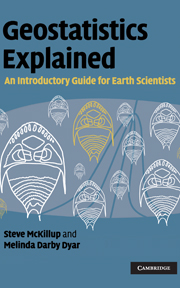Book contents
- Frontmatter
- Contents
- Preface
- 1 Introduction
- 2 “Doing science”: hypotheses, experiments and disproof
- 3 Collecting and displaying data
- 4 Introductory concepts of experimental design
- 5 Doing science responsibly and ethically
- 6 Probability helps you make a decision about your results
- 7 Working from samples: data, populations and statistics
- 8 Normal distributions: tests for comparing the means of one and two samples
- 9 Type 1 and Type 2 error, power and sample size
- 10 Single-factor analysis of variance
- 11 Multiple comparisons after ANOVA
- 12 Two-factor analysis of variance
- 13 Important assumptions of analysis of variance, transformations and a test for equality of variances
- 14 Two-factor analysis of variance without replication, and nested analysis of variance
- 15 Relationships between variables: linear correlation and linear regression
- 16 Linear regression
- 17 Non-parametric statistics
- 18 Non-parametric tests for nominal scale data
- 19 Non-parametric tests for ratio, interval or ordinal scale data
- 20 Introductory concepts of multivariate analysis
- 21 Introductory concepts of sequence analysis
- 22 Introductory concepts of spatial analysis
- 23 Choosing a test
- Appendices
- References
- Index
7 - Working from samples: data, populations and statistics
Published online by Cambridge University Press: 05 June 2012
- Frontmatter
- Contents
- Preface
- 1 Introduction
- 2 “Doing science”: hypotheses, experiments and disproof
- 3 Collecting and displaying data
- 4 Introductory concepts of experimental design
- 5 Doing science responsibly and ethically
- 6 Probability helps you make a decision about your results
- 7 Working from samples: data, populations and statistics
- 8 Normal distributions: tests for comparing the means of one and two samples
- 9 Type 1 and Type 2 error, power and sample size
- 10 Single-factor analysis of variance
- 11 Multiple comparisons after ANOVA
- 12 Two-factor analysis of variance
- 13 Important assumptions of analysis of variance, transformations and a test for equality of variances
- 14 Two-factor analysis of variance without replication, and nested analysis of variance
- 15 Relationships between variables: linear correlation and linear regression
- 16 Linear regression
- 17 Non-parametric statistics
- 18 Non-parametric tests for nominal scale data
- 19 Non-parametric tests for ratio, interval or ordinal scale data
- 20 Introductory concepts of multivariate analysis
- 21 Introductory concepts of sequence analysis
- 22 Introductory concepts of spatial analysis
- 23 Choosing a test
- Appendices
- References
- Index
Summary
Using a sample to infer the characteristics of a population
Usually you cannot study the whole population, so every time you gather data from a sample you are “working in the dark” because the sample may not be very representative of that population. You have to take every possible precaution, including having a good sampling design, to try to ensure a representative sample. Unfortunately you still do not know whether it is representative! Although it is dangerous to extrapolate to the more general case from measurements on a subset of individuals, that is what researchers have to do whenever they cannot work on the entire population.
This chapter discusses statistical methods for estimating the characteristics of a population from a sample and explains how these estimates can be used for significance testing.
Statistical tests
Statistical tests can be divided into two groups, called parametric and non-parametric tests. Parametric tests make certain assumptions, including that the data fit a known distribution. In most cases this is a normal distribution (see below). These tests are used for ratio, interval or ordinal scale variables. Non-parametric tests do not make so many assumptions. There is a wide range of non-parametric tests available for ratio, interval, ordinal or nominal scale variables.
The normal distribution
A lot of variables, including “geological” ones, tend to be normally distributed.
- Type
- Chapter
- Information
- Geostatistics ExplainedAn Introductory Guide for Earth Scientists, pp. 66 - 84Publisher: Cambridge University PressPrint publication year: 2010

